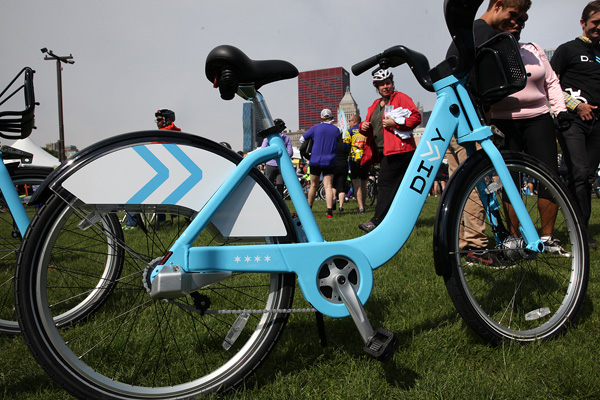
Photo: Nancy Stone/Chicago Tribune
The Atlantic Cities' Henry Grabar has an interesting piece about bike shares, bike infrastructure, and class. As he notes, "cyclist" has become a byword for "elitist" (itself code for "youngish, well-educated person," not "rich") even though it doesn't really reflect the numbers or, in my experience riding around Chicago, the on-the-ground anecdotal evidence.
It's weird. I can see this charge being thrown around if Rahm Emanuel and Michael Bloomberg were rolling out dedicated Vespa lanes. But I grew up in the country, where all the kids had bikes and rode them for fun, not for transport or ideology. Above all it just seems like a wholesome form of transportation. It's like objecting to 16-inch softball for being elitist.
But the bike-share audience is pretty elite:
But the biggest difference between CaBi [Capital Bikeshare in D.C.] users and the working population is level of education. Even taking into account the fact that the Washington metro area is the best-educated region in the country, with nearly half the population holding a bachelor's degree, Capital Bikeshare's membership is shockingly learned. Ninety-five percent of CaBi users have a four-year college degree, and another four percent have "some college."
That's like specialized-journal-subscriber levels of education; to counteract this, cities have subsidized bike shares for low-income residents. Grabar sees a different problem, and I think he's got a point:
But as bike travel begins to work its way into the mainstream of urban American routine, its claim to egalitarianism will be challenged. Cyclists are right that bicycle travel ought not be limited by race, by wealth, or by culture. But as they attempt to diversify cycling, they will find a more intractable barrier, one that threatens to make urban bicycle commuting the mode of the privileged: distance.
My friend @muziejus built a map of the proposed Chicago bike-share locations, and overlaid it on the CTA lines and household median incomes in Cook County. They don't go west of Pulaski or very far south of Hyde Park. The stations cluster near El lines, but on the Oak Park branches of the Green and Blue Lines, the bike-share stations stop at Damen. This leaves broad swaths of the city's poorest neighborhoods uncovered.
Then again, they don't go northwest along the Milwaukee Avenue corridor, which leaves the vast residential area around Portage Park, Irving Park, Hermosa, and so forth also far distant from bike-share stations. Basically the whole west side of the city has no bike-share stations, which includes some growing, thriving neighborhoods in the north- and southwest corners of the city—areas that are sort of distant from the El or Metra stations and where a bike-share-to-train commute would seem to make some sense. Take a look.
What I get from the map is that it's serving commercial-dense areas. Chicago's poor neighborhoods are remarkably commerce-sparse, but the stations also skip the reasonably well-off but mostly residential (and less housing-dense) neighborhoods to the northwest as well. There's some interesting discussion at his blog, and John Greenfield of Streetsblog weighs in:
In any case, it’s common to get a foothold for a bike-share system by launching in the areas of the city with the highest residential and job density, where use will be most intense, then expanding once the concept has been proven and there’s definitely support for subsidizing it.
A commenter on Grabar's post makes a similar point:
You raise a number of important points, but I think you are being a little short-sighted about the historical reasons for some of these issues and the limits of what bike-sharing (or other pro-bike programs) can do. For example, you state: "the problem is more fundamental: cities are concentrating bicycle infrastructure where bike commuting will be convenient, in dense neighborhoods close to central business districts." -This is something of a straw man argument. City officials are under pressure to demonstrate that bike infrastructure is (1) necessary, and (2) used. AND there is virtually no money for such infrastructure, so if you were in this position, where would you build infrastructure?
Part of the problem is that bike-share programs are currently being overlaid on cities that have been hollowed out by the decentralization of jobs. People didn't just flee cities; employers did, making poor neighborhoods car-dependent:
As Mark Alan Hughes, William Julius Wilson, and other scholars have documented, the steady movement of jobs out of cities and into the suburbs has helped create and sustain the concentrated poverty that is now endemic to America's urban areas. Because new jobs tend to be located in ever-expanding suburbs, which are poorly served by mass transit, poor central-city residents find themselves living further and further away from economic opportunities. Evelyn Blumenberg, a professor of urban planning at UCLA, found that car-driving residents of the Watts section of Los Angeles have access to an astounding 59 times as many jobs as their neighbors dependent on public transit. Even more isolated are the car-less low-income families that now live in the suburbs–nearly half of all metropolitan poor.
Employers are slowly starting to shift back to central cities, but any new transportation infrastructure is going to have to grapple with the legacy of the old. Fortunately, bike-sharing is comparatively low-impact and nimble, leaving hope that it can shift to serve more of the city.



